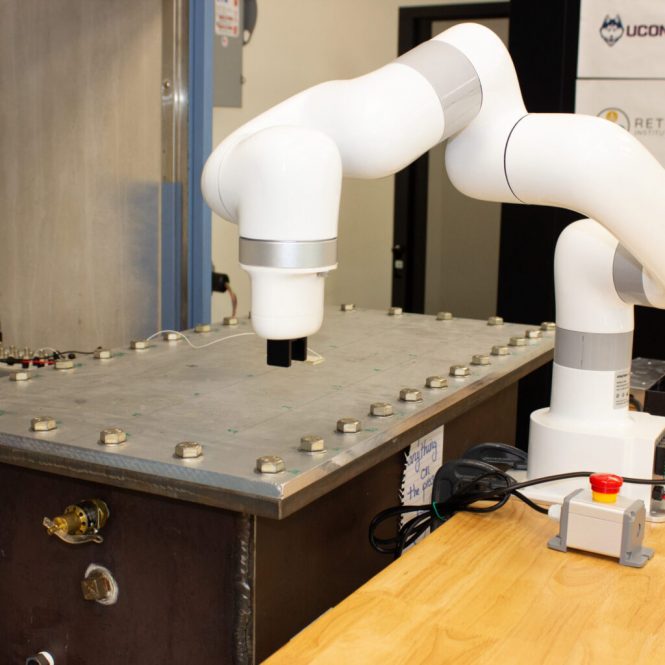By Lisa Ferraro Parmelee
“The keyword here is resilience,” says Professor Ali Bazzi. “Resilient extraterrestrial habitats.” He is talking about UConn’s part of a NASA-funded Science and Technology Research Institute (STRI) to support projects like Artemis, the most exciting NASA project in decades that hardly anyone seems to know about.
Artemis aims to return humans to the moon and establish a base there that will serve as preparation for manned missions to Mars, where another base will be built as a habitat for astronauts to live and work. As part of the Resilient Extra-Terrestrial Habitats (RETH) institute, led by Purdue University, researchers at UConn School of Engineering are responsible for four vital aspects of this undertaking:
- Power systems infrastructure, diagnostics, and power rerouting in space microgrids
- Robotics, to operate in space and maintain and repair the habitat
- Communications, to enable the habitat systems to communicate with each other and with Earth
- Monitoring, to diagnose, for example, the damage to the habitat from a meteorite strike
According to Bazzi, who heads the project at UConn, the big news from the School of Engineering is the recent completion on the Storrs Depot Campus of a cyber-physical testbed, where, he says, “All of these four themes basically lump together.” Students, each of whom worked on a subsystem serving one of these areas, can now run computer simulations and physical experiments to test the technology essential to the habitat’s operation and survival.
One of those students is Hasnain Nisar, an electrical and computer engineer in the first year of his Ph.D. program at UConn. The testbed, he explains, incorporates physical components, such as solar arrays, pressure and temperature controls, and electronic loads that mimic habitat power loads, along with cyber components to simulate, for example, nuclear generation and energy storage systems. Nisar built the hardware for the implementation of power systems for the habitat, while Leila Chebbo, another Ph.D. student whose research interests are power systems and renewable energy, has developed the algorithms.
All scientists and engineers are, understandably, most engaged with their own specializations. For Nisar, whose expertise is in electric machines, drives, and microgrids, the most exciting part of the project is the prioritization of power loads. “Let’s suppose we have less power. Which load is more important in space?” he asks. “In case of low power, lighting is not something that is needed for life. Pressure and heat might be. So how should these be prioritized in case of any disturbance?”
The implications of this work go far beyond the needs of space travel. Ultimately, the RETH project is about making uninhabitable places habitable. And as climate change advances, and communities run out of water or burn in wildfires, and power grids struggle through increasingly brutal heatwaves and extreme cold, the terrestrial applications of this technology will become increasingly relevant.
Still, it’s the goal of supporting life in extraterrestrial places that really fires the imagination.
It has, after all, been more than half a century since humans last walked on the surface of a planetary body other than Earth. What would Bazzi say to the engineers, scientists, and technicians who dedicated their lives, labor, and ingenuity to putting them there long ago, only to see their grand endeavor fade away in the years that followed?

Rounak Bhattacharya (ECE)
Leila Chebbo (ECE)
Vrithik Guthikonda (ECE)
Hasnain Nisar (ECE)
Ghananeel Rotithor (ECE)
Jiachen Wang (CSE)
Chuanyu Xue (CSE)
Yang Zhang (ME)
Qianyu Zhou (ME)
“This is accelerating now,” he would tell them, “and there are many, many brains working between NASA, industry, and academia. We will have the ability, not just to visit the moon and come back, but to have people live on planets and moons and use one as a launchpad to another and then maybe the other as a launchpad to someplace else. We need to explore a new frontier.”
As Nisar more simply puts it, “This thing is really going to be happening.” And, maybe not too long from now, he, Bazzi, and the rest of their UConn team will be among those who—much like those earlier pioneers—will watch the arrival of explorers on other planets and be able to say, “We did that.”
—
The University of Connecticut’s part in the Resilient Extra-Terrestrial Habitats (RETH) institute is being conducted by a dedicated team of faculty and students from UConn School of Engineering. Professor Ali Bazzi is leading the research on power systems, while Professor Ashwin Dani is in charge of robotics. Communications is led by Professor Song Han and monitoring by Professor Jiong Tang. The following graduate students from the departments of electrical and computer engineering (ECE), computer science and engineering (CSE), and mechanical engineering (ME) have all contributed to the creation of the testbed:
Rounak Bhattacharya (ECE)
Leila Chebbo (ECE)
Vrithik Guthikonda (ECE)
Hasnain Nisar (ECE)
Ghananeel Rotithor (ECE)
Jiachen Wang (CSE)
Chuanyu Xue (CSE)
Yang Zhang (ME)
Qianyu Zhou (ME)



